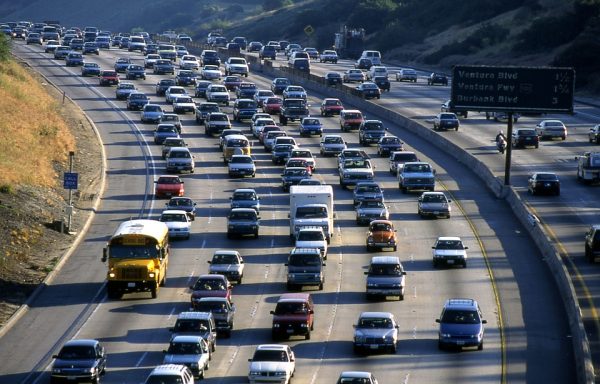Traffic Congestion: Three Big Questions, Three Short Answers
 Traffic congestion is a bane of urban life. Cities have other serious problems, of course, but few of these problems touch such a large share of city residents on a daily basis. In part for this reason, congestion gets a tremendous amount of attention from elected officials, residents and news organization. We offer three core ideas to keep in mind when covering congestion:
Traffic congestion is a bane of urban life. Cities have other serious problems, of course, but few of these problems touch such a large share of city residents on a daily basis. In part for this reason, congestion gets a tremendous amount of attention from elected officials, residents and news organization. We offer three core ideas to keep in mind when covering congestion:
Why do we have so much congestion?
Roads get congested because they are free to use. This fact is the central concept to understanding traffic congestion. Without it, nothing else about congestion makes sense.
When goods are underpriced, they are prone to shortages — in general, it is the things we don’t charge for that become the things we run out of. We choose to leave our roads free despite them being very valuable, and as a result they get overused and congested. We can see the role of prices in congestion when we compare roads to other public infrastructure: We charge people to use water and heating oil and electricity, and as a result we rarely see these systems crash from overuse. We can also see this if we compare the roads to other aspects of driving. Everyone who uses the road also uses vehicles and gasoline, but we do not suffer shortages of those. That’s because we allocate vehicles and gasoline with prices — they get more expensive when more people want them. We choose to leave the road unpriced, however, and as a result we run out of it: congestion.
Understanding that congestion occurs because roads are free makes clear that the only way to reduce congestion is to charge a price to use the road. This approach, known as congestion pricing, is often politically unpopular but has proven effective in the places that have tried it. Other approaches, like building comprehensive mass transit, do not reduce congestion, if by “reduce congestion” we mean “make driving faster at busy times.” (A quick example: New York City has one of the most extensive transit systems on earth. It also has horrible traffic. The subway lets people who prefer not to drive avoid congestion, but it does not make the congestion go away).
One can argue that in the name of fairness we should leave our roads free. That’s a separate argument (about which we have other thoughts). The important point for now is that if we choose to leave the roads unpriced, we are choosing to have congestion.
How bad is traffic congestion for the economy?
A typical news story about traffic congestion might start something like this: “Once again Los Angeles is one of the most congested regions in the United States. Traffic congestion continues to exact a huge toll on our region’s economic vitality and quality of life. The average driver loses X hours a year to traffic, results in Y gallons of wasted fuel, and congestion’s total cost to the economy is Z.” X, Y and Z, of course, are often eye-popping numbers.
Something to note about these narratives is that they often involve comparisons across regions as well as comparisons within regions. A typical congestion ranking, for example, might calculate the severity of congestion in LA by examining how often roads are congested to how often they are free-flowing (a comparison within the region), and ranking that delay alongside the delay faced by people elsewhere (a comparison across regions). There is nothing inherently wrong with this approach, but it can create some confusion.
In part the confusion arises because congestion is an affliction of affluence. A list of the most congested urban areas in the country is a list of prosperity. New York and San Francisco have terrible congestion. Youngstown, Ohio, and Flint, Michigan, do not. This relationship is sensible: In vibrant economies, people have more places to go. More people are driving to work (both because there are more jobs and more people with the income to buy cars and gas), and more people have discretionary income to spend driving off to dinner, to cultural or sporting events, or just to visit friends across town. So congestion is certainly correlated with economic health, and found in vibrant places that offer more opportunity.
The association between congestion and affluence could lead some people to conclude that congestion isn’t bad for the economy. This would be a mistake: congestion is absolutely a drag on the economy. It’s true that congested Los Angeles is a richer place than uncongested Buffalo, but this comparison misses the mark. Los Angeles also has more air pollution than Buffalo, but no one thinks air pollution helps LA’s economy. So the question is not whether we’d prefer to live in Buffalo or LA. The real question is whether Los Angeles would have a stronger economy if all else equal it had less congestion. The answer to that question is a resounding yes. LA offers more opportunities to its residents than does Buffalo. But LA would offer even more opportunities than it does today if driving across it was faster and more predictable; if snarled roads did not elevate stress levels and pollute its air (sickening many of its children); if the sheer density of vehicles did not elevate the risk and incidence of collisions; and if the mere prospect of traffic did not convince many people to stay home rather than venture out. Congestion makes Los Angeles, and other big urban areas, into places that are less than the sum of their parts. Congestion is a byproduct of a strong economy, but it nevertheless weakens the strong economy that created it.
Having said all that, precisely estimating the cost of congestion is extremely difficult, which is one reason organizations making such estimates often get a fair amount of pushback. Estimating congestion costs requires making assumptions about how much people value their time, about what people would do in the absence of congestion, about vehicle fuel economy in different road conditions, and so on.
A more conceptual criticism sometimes levied at these rankings is that they create a misleading impression of congestion’s importance. Yes, it creates difficulty in getting around. Focusing exclusively on congestion, however, can ignore that with the right policies even congested cities can offer lots of accessibility. The same density that makes roads congested also puts destinations closer together, and can make transit more effective. Similarly, many less-congested areas ar so precisely because destinations are further apart. So what’s worse: driving 10 minutes in congestion in a dense area, riding transit 20 minutes in the same area, or driving 15 minutes on largely empty roads in an uncongested area? Is congestion what matters, or the overall time and effort spent travelling?
This question, which may have no correct answer, is another argument against comparing the burden of congestion in different regions. Congestion is a serious problem, but the policy question it presents is not whether one city can beat another. Instead it is how we can improve the big, dense urban areas that contribute disproportionately to our economy, by reducing congestion within them and opening up their opportunities to even more people. The answer, as we alluded to above, is that we can do this by pricing our busy roads.
Is there some way to reduce congestion without using pricing?
No. Pricing reduces congestion. Nothing else does. Pricing is a bitter pill — no one wants to pay for something they are accustomed to getting free — but it is the medicine that works.
Cities have tried for decades to reduce congestion by adding new freeway lanes and expanding rail transit systems. These efforts do not work, because they mistakenly assume that the current amount of traffic on our roads represents the total amount of traffic possible — essentially, that everyone who would like to be driving on a busy road already is.
Were this the case, then pulling a driver off the 405 freeway at 6 p.m. on an average weekday, and putting them on a train instead, would free up some road space and let all other vehicles move faster. Adding another lane to the freeway would have the same effect.
But the fact is the drivers we see on freeways at busy times are only the tip of an iceberg — many people would like to drive on that road at that time of day.
There are drivers who would ideally travel at 6 p.m. on the 405 but instead travel earlier or later to avoid congestion. There are others who choose to travel at 6 p.m. but do so on roads other than the 405 to avoid congestion. There are people who travel at 6 p.m. via other modes, even though driving on the 405 would be their preferred choice, if only congestion was lower. And there are people sitting at home who would make a trip on the 405 at 6 p.m. except that the road is too crowded. When the road becomes less crowded — as it momentarily would if we add a lane or a train — some of these people will converge onto the 405 at 6 p.m., and soon the road will be every bit as congested as it was to begin.
This phenomenon of “latent demand” is one of the most firmly established facts in the study of travel behavior. Latent demand is the reason that new capacity cannot reduce congestion. Congestion itself is a cost of driving, so reducing congestion makes driving less expensive. Since you can’t reduce the demand for something by making it cheaper, efforts to relieve congestion are bound to be self-undermining, unless a money cost replaces the time cost that is stripped away. Congestion pricing works for precisely this reason.
UCLA Institute of Transportation Studies Contacts
For Reporters on Deadline:
Claudia Bustamante, Communications Manager
424-625-8468 / claudb@ucla.edu
Additional Resources:
Longer View: The Fairness of Congestion Pricing
Traffic Congestion is Counter-Intuitive, and Fixable
Moving Los Angeles: Short-Term Policy Options for Improving Transportation
Reducing Traffic Congestion and Improving Travel Options in Los Angeles




